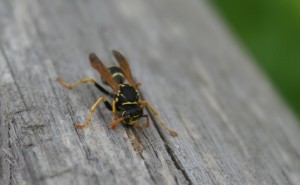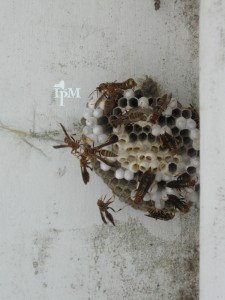Paper wasps are social, stinging insects that build open-comb nests. These nests are often found on the protected undersides of natural or man-made overhangs. Soft-bodied insects, nectar, and honeydew are important food sources for paper wasps. These insects can be a public health concern when they nest near human activity because of their potent sting.

Did You Know…?
- By the numbers: There are 22 species of paper wasps in North America. The two most common paper wasp species in the Northeast are the native northern paper wasp and the invasive European paper wasp.
- Watching it’s figure: Paper wasps can be distinguished from other wasps and yellowjackets by its very thin “waist”.
- What’s in a Name?: Paper wasps use their mandibles (jaws) to scrape wood from plants, decks, or siding and combine it with saliva to make a papery nest.
- Danger!: Paper wasps have unbarbed stingers, so they can deliver multiple stings. European paper wasps in particular are very aggressive when protecting their nest.
- Look-alikes: European paper wasps are often confused with yellowjackets due to their similar black and yellow color. This species can be distinguished by its dainty waist and the position of its legs when it flies, which dangle below its body. (Yellow jacket legs are much shorter and held tight against the body.)
- Beneficial Predator: Paper wasps feed their larvae caterpillars which can be garden pests.

Paper wasps can build their umbrella comb nests under any protected ledge or overhang.
Integrated pest management can help to determine if a paper wasp nest is a danger and what to do if it should be removed. For more information visit:
- Paper Wasps: Friend or Foe? fact sheet
- Inspect for Wasps and Avoid the Sting blog post
- Stinging Insect IPM video
For more information from the New York State IPM Program on other stinging insects, click here.